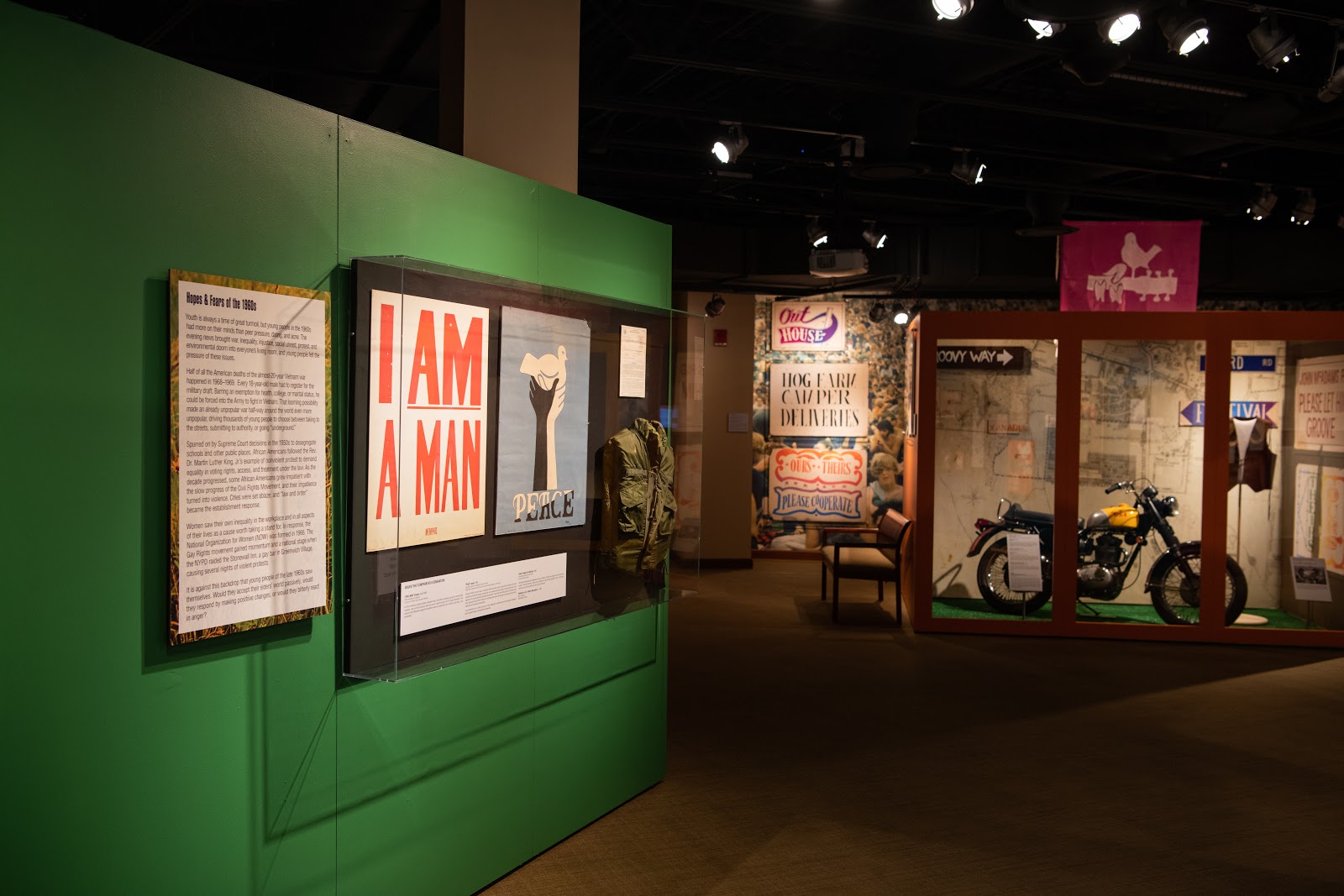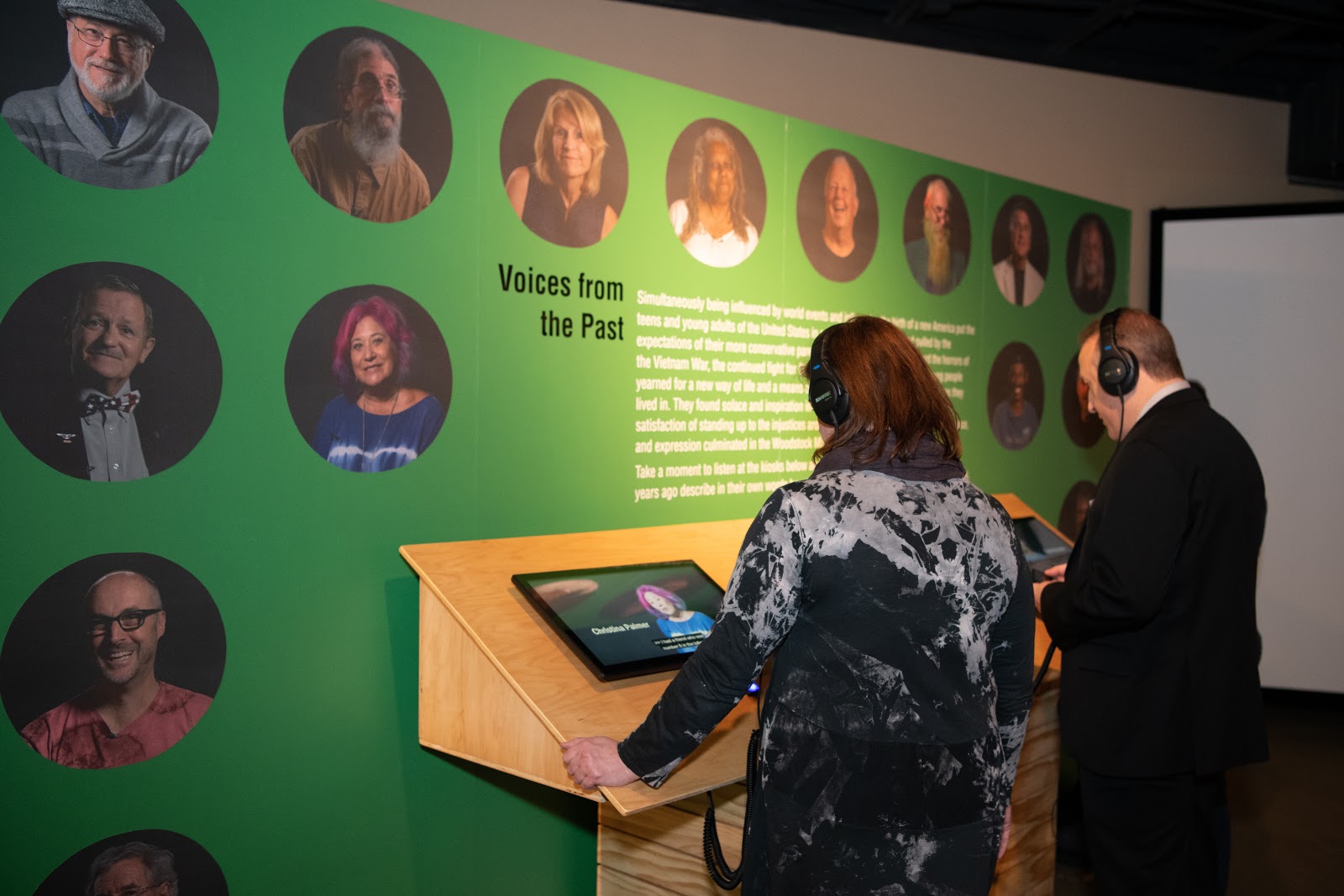We Are Golden: Reflections on the 50th Anniversary of the Woodstock Festival and Aspirations for a Peaceful Future, an exhibition at the Museum at Bethel Woods celebrates and interprets Woodstock’s golden anniversary through artifacts, oral histories, and mixed media and connects social movements in the 1960’s to events at Woodstock and beyond by drawing parallels from then to today.

Inside the We Are Golden exhibition where visitors can see over 170 artifacts like the festival site plans, Michael Lang’s motorcycle (pictured above) and hear music from the festival and stage announcements. Image courtesy The Museum at Bethel Woods.
The exhibition is comprised of a large collection of authentic Woodstock artifacts including instruments, clothing, equipment, art, and photography. It examines Woodstock and what the youth of 1969 wanted for the world at a time when an entire generation felt slighted and silenced. Through the use of artifacts and testimonies, this exhibition explores the communal response of generation of young people who returned to the “real world” following a massive, peaceful gathering with a better sense of solidarity, which in turn influenced their desire for a more peaceful existence. 
The determination and desire for change in those who attended Woodstock makes them not unlike some of the young people involved social movements that are happening in the world today. Contemporary social action movements, including Live Aid, Farm Aid, Earth Day, the Women’s Movement, the LGBTQ Movement, #metoo, the Women’s March, and the student gun control movement, all have their roots in 1960s social and civic activism.
The Museum at Bethel Woods sourced over 170 artifacts, some from their permanent collection, and others on loan from festival attendees and performers -- like the bass and tunic from former Jefferson Airplane and currently Hot Tuna band member Jack Casady. Yet, what connects the visitor to the moment in time of being at Woodstock in 1969 are the oral histories from festival attendees and hearing conversations with young people from across the country today about their hopes, their dreams, and calls for social movements and change.

“Voices from the Past” exhibition panel where visitors can listen to oral histories from those who attended and worked at Woodstock. Visitors can listen to what these peoples’ hopes, fears, and expectations were for the time. Image courtesy The Museum at Bethel Woods.
While oral historian Kevin Ferguson compiled most of the elders older histories for "Voices from the Past", oral historians Rachel Marco-Havens and Steven Palmer (The Stonewall Project) traveled across the United States to capture stories told by people ages 14 to 30 who identify as leaders and members of social movements that cross race, gender, and socioeconomic identities.1 Rachel and Steven traveled from California to New Mexico, Florida, and as far north as the Sioux Nation at Standing Rock. During these interviews, they found similar concerns between the 1960s like the Vietnam War, civil rights, women’s rights, LGBTQ rights and others to concerns felt by today’s youth. Today’s climate change, the me too movement, and equality echo the concerns from the 1960s.
Stories gathered by Marco-Havens and Palmer connect young people across the country today, some of which identify as leaders and are engaged in social movements, and reflect on their hopes, fears, and aspirations, how they can learn from the Woodstock generation, and what they hope subsequent generations can learn from them. Like those who attended Woodstock and were involved in social movements in the 1960s, today’s youth movements and activists hope to create meaningful impact for the world. We Are Golden examines the “after” of Woodstock and the return to the real world with a “What the World Needs Now” kiosk that includes some of those who attended the 1969 festival but focuses on the voices from today’s youth. These kiosks (“Voices from the Past” and “What the World Needs Now”) categorize both of these generations’ voices by their hopes, fears, and expectations for the future. In these voices, you can hear the parallels to today:
Hopes
“There was a yearning to make things better. To make things whole. Even a seventeen-year-old like myself could see that the country was really torn apart. Really torn.” Mike Levine, “Voices from the Past”
“My hope is in each conversation, have the youth represented and our voice heard, and just to have our input on how and what we want the future to look like.” Jasilyn Charger, “What the World Needs Now”
Fears
“We had tension back in 1969, you know, with the war in Vietnam and everything, but people just let all their politics aside for Woodstock.” Bob Gould, “Voices from the Past”
“My fear is that things ultimately will not get better. That history is not necessarily linear, but that things are a bit cyclical and human history just kinda all about struggle. So my fear is that that’s kinda what we’re living in, where essentially it’s kind of all about human struggle and human survival and things don’t necessarily get better.” William Grant, “What the World Needs Now”
Expectations
“What is takes for the planet to go... It needs all of us. It needs community. We need to talk to each other, we need to communicate with each other.” Janice Inabinett, “Voices from the Past”
“It definitely takes action. It definitely takes a movement. It definitely takes a lot of collectiveness in order to combat that. In order to feel safe in this world. In order to feel loved in this world.” KC Cornish, “What the World Needs Now”
Assistant Curator Julia Fell noted that the parallels in these voices “are the desire for communication, the desire and belief in change, and the cyclical nature of history.”
The special exhibition is rooted in a shared, communal experience echoing the experience at Woodstock. “In the second half of the museum exists a replica Message Tree. In 1969, a lone red maple tree stood at the corner of West Shore and Hurd Roads, the crossroads of the Woodstock Festival. The tree was the only living thing of any height for a hundred yards in any direction,” explains Director and Senior Curator Wade Lawrence. “Festival attendees used the tree, as a message board, to post messages on paper plates or whatever could be found.” Today, museum guests are invited to share their thoughts upon the Message Tree with the young people of today who inherited this world and will find their own ways to respond to it. Messages include the simple “I was here,” a child’s drawing, or thoughts abouthow they want their world to look.

The replica of the Message Tree, designed to model the landmark tree on the field at Woodstock. The original, a red maple tree would serve as a meeting point and be covered in messages like asking people for rides, times to meet, etc. This replica Message Tree (pictured above) allows visitors to We Are Golden to leave their own thoughts about the exhibition and what they want to see in the world. Image courtesy The Museum at Bethel Woods.
The Museum at Bethel Woods asks visitors to think more about the world around them and to see the parallels with the 1960s. The exhibition offers the opportunity to hear young people today share their concerns and hopes for the future or for those who lived in the 1960s to ask if and how those movements for social change resolved. Woodstock became a symbolic moment that seemed to capture the entire context of the 1960s. We Are Golden prompts us to reflect not just on that time but on the world today and if we are living in a similar moment, or if that moment has passed.
1Oral historian Rachel Marco-Havens is an independent youth leadership mentor and is the daughter of Woodstock performer Richie Havens. Rachel and Steven had never met before prior to this project and worked mostly independently of one another as they captured these oral histories.
Further Reading / Resources
The Museum at Bethel Woods
https://www.bethelwoodscenter.org/the-museum
Oral History Association
https://www.oralhistory.org/
